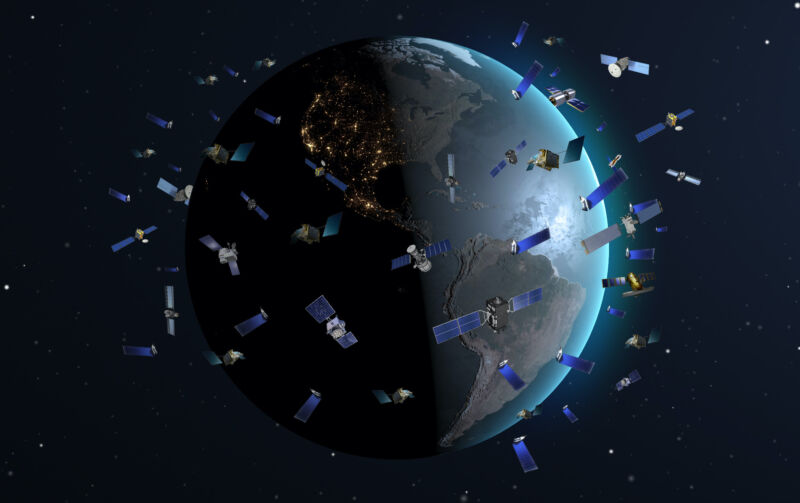NASA has warned that SpaceX's plan for 30,000 more Starlink satellites could cause problems for science missions, human spaceflight, the Hubble telescope, and ground-based telescopes that look for asteroids that might hit the Earth.
NASA outlined its concerns in a letter to the Federal Communications Commission on Monday. "With the increase in large constellation proposals to the FCC, NASA has concerns with the potential for a significant increase in the frequency of conjunction events and possible impacts to NASA's science and human spaceflight missions," the agency said. "Consequently, NASA submits this letter for the purpose of providing a better understanding of NASA's concerns with respect to its assets on-orbit and to further mitigate the risk of collisions for the benefit of all involved."
NASA didn't urge the FCC to reject SpaceX's application, but it said it wants deployment to be "conducted prudently, in a manner that supports spaceflight safety and the long-term sustainability of the space environment." NASA also said the large number of additional satellites "will require expanded coordination and communication between the two parties to ensure the continued safety of both SpaceX and NASA assets."
Hubble telescope and asteroid surveys
The Hubble orbits at 535 km, and about "8 percent of composite images captured by the Hubble telescope are impacted by satellites captured during exposures," NASA said. "This proposed Starlink license amendment includes 10,000 satellites in or above the orbital range of Hubble, a situation that could more than double the fraction of Hubble images degraded." NASA also said that "degradation severity will increase."
NASA said it has approximately 14 Earth-observing missions and that SpaceX's planned altitudes for the 30,000 satellites are lower than most of the space vehicles used in those missions. That raises the "potential for sun-glint and reflections from the Starlink spacecraft to cause impacts to those missions' measurements."
Next, NASA noted that it "uses wide-field ground-based telescopes to survey for asteroids that could potentially impact the Earth and cause harm" and that these "telescopes occasionally find satellite streaks in their images that could interfere with or hide asteroid detections." Starlink's plans could make that problem quite a bit worse, NASA said:
With the addition of ~30,000 Starlink satellites as described in the Gen2 amendment request, NASA estimates that there would be a Starlink in every single asteroid survey image taken for planetary defense against hazardous asteroid impacts, decreasing asteroid survey effectiveness by rendering portions of images unusable. This could have a direct impact on NASA's ability to fulfill its Congressional mandate and could have a detrimental effect on our planet's ability to detect and possibly redirect a potentially catastrophic impact.
To address this risk, NASA said it wants "additional information including: spacecraft and laser specifications including deployed dimensions, communications plan, ground segment expansion, orbital spacing, and deployment schedule. This will inform a thorough analysis of risks and impacts to NASA's missions and enable a mitigation strategy."
We've previously written about how astronomers have observed growing numbers of Starlink satellite tracks on telescope images and about a report by astronomers stating that the effect on the night sky of Starlink satellites can't be eliminated.
NASA sees problems for launch windows
Launches could be affected by the Starlink plan, NASA said. "SpaceX is proposing ~20,000 additional Starlink satellites in the 328-360 km altitude range, which is below the ISS and is a common phasing altitude for ISS visiting vehicles," NASA's letter said. "The proposed volume of autonomously maneuvering satellites directly parked in common phasing altitudes could result in potential loss of launch/entry opportunities impacting science and utilization for ISS."
NASA also said it is worried about "an increasing unavailability of safe launch windows, especially for missions requiring instantaneous or short launch windows, such as planetary missions like the Europa Clipper, which would be significantly affected due to a lost launch opportunity." NASA recommended that "SpaceX commission analysis of launch window availability... to demonstrate that the increase in launch conflicts does not significantly reduce access to space. NASA is specifically interested in analysis that may predict how this expansion impacts future NASA Science Missions, Commercial Crew, and Re-Supply launch/entry opportunities."
The letter was signed by Samantha Fonder, NASA's representative to the Commercial Space Transportation Interagency Group. A handful of satellite companies also submitted filings to the docket on or before the February 8 deadline for comments. Viasat petitioned the FCC to deny SpaceX's application or hold it in abeyance, and Dish petitioned the FCC to dismiss or deny the application in part. EchoStar and Hughes called on the FCC to dismiss or suspend review of the SpaceX application.
Amazon, which has frequently battled with SpaceX over Starlink plans, asked for conditions to be imposed on the launches. OneWeb also asked the FCC to impose conditions. The 30,000 satellites pending approval are in addition to the nearly 12,000 that SpaceX already has licenses for. SpaceX has about 1,900 Starlink satellites in orbit so far.



3175x175(CURRENT).thumb.jpg.b05acc060982b36f5891ba728e6d953c.jpg)

Recommended Comments
Join the conversation
You can post now and register later. If you have an account, sign in now to post with your account.
Note: Your post will require moderator approval before it will be visible.